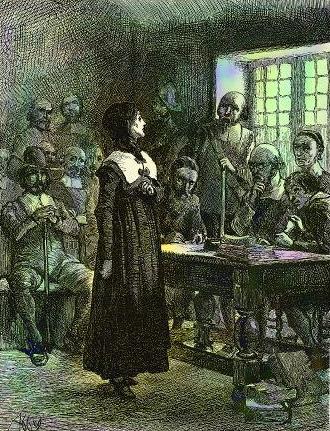Many people came to the American colonies hoping to practice their religion freely. In Europe, certain churches were supported by governments, and people who disagreed with those churches could be fined, arrested, or worse. Some colonists wanted to escape those limits and start new communities where they could follow their own beliefs. But even in the colonies, full religious freedom was rare. In many places, colonists made rules that protected only their own religion and did not allow others to worship freely. Instead of welcoming different beliefs, many colonial leaders passed laws that punished people for worshiping in ways they did not approve of.
Religious Rules in New England
The Puritans in Massachusetts left England because they were treated unfairly for their religious beliefs. But after starting their own colony, they made strict rules that everyone had to follow. People who did not agree with Puritan teachings could be punished or forced to leave.
Roger Williams and Anne Hutchinson were two colonists who openly disagreed with the Puritan leaders. Roger Williams believed that religion should not be controlled by the government. He said that people should be free to follow their own beliefs and that taking land from Indigenous peoples without payment was wrong. Because of his views, he was banished from Massachusetts in 1635. He traveled south and founded the colony of Rhode Island, where religious freedom was protected by law.
Anne Hutchinson also challenged Puritan leaders, but in a different way. She held meetings in her home where she shared her own interpretations of religious teachings. She believed that people could have a direct relationship with God and did not always need ministers to tell them what to believe. This angered church leaders, who said she was a threat to their authority. She was put on trial and forced to leave the colony. Hutchinson later moved to Rhode Island and then to New Netherland (now New York).

Both Williams and Hutchinson showed that not everyone in the colonies accepted limits on religious freedom. Their actions helped create spaces where people could think and worship differently.
Official Churches and Punishment
Some colonies supported one official church. In Virginia, for example, the Church of England was the only legal church for many years. People who belonged to other religions could be taxed to support the official church or punished for holding their own services.
These rules limited religious freedom by making it harder for people to practice other beliefs. Some groups could not vote, own property, or hold public office if they did not belong to the official church.
The Maryland Toleration Act
Maryland was founded as a place where Catholics could worship safely. But over time, more Protestants moved into the colony. To reduce conflict, colonial leaders passed the Maryland Toleration Act in 1649.
This law said that Christians could not be punished for practicing their religion. However, the law only protected people who followed common Christian teachings. It did not protect people of other religions or people who disagreed with certain Christian ideas. So while the act was a step toward religious tolerance, it still had limits.
The Salem Witch Trials
One of the most extreme examples of religious fear was the Salem Witch Trials in Massachusetts in 1692. Some colonists believed that people in their town were practicing witchcraft, which they saw as dangerous and evil. These beliefs led to a series of trials and punishments. More than 20 people were executed, and others were jailed, even though there was little or no evidence against them. This event showed how strict religious rules could lead to serious injustice.

People Who Challenged Religious Limits
Some colonists worked to change how religion was treated. Roger Williams believed that government and religion should be separate. Bartolomé de Las Casas spoke out against the unfair treatment of Indigenous peoples by church and colonial leaders. While these individuals did not always bring immediate change, their ideas helped shape future views on religious freedom.
